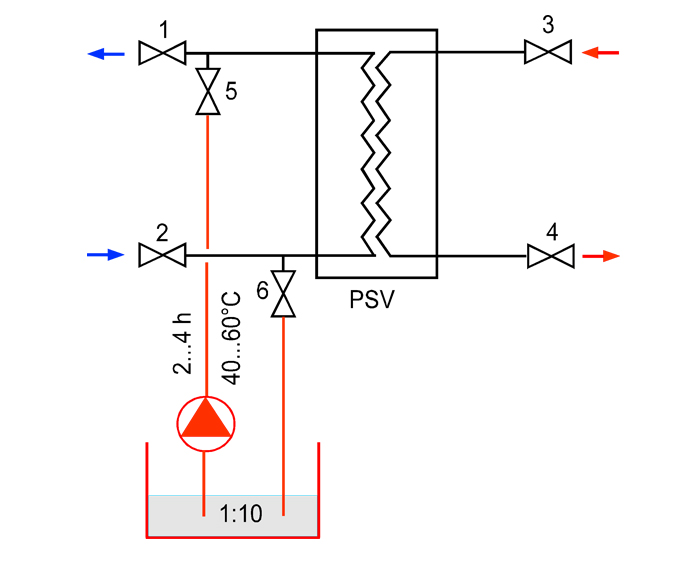Veuillez ne pas bloquer les publicités sur notre site. Les clics sur les annonces nous aident à exister, à nous développer et à devenir plus utiles pour vous !
Nettoyage chimique de l'échangeur de chaleur à plaques
Les dépôts sur les plaques de l'échangeur de chaleur, qui se forment au cours de l'exploitation, augmentent la conductivité thermique des plaques et réduisent la section transversale des canaux de passage du fluide de travail. Le degré de contamination de l'échangeur de chaleur est évalué par l'augmentation de la résistance hydraulique et la diminution des caractéristiques thermodynamiques.
Types de contamination des échangeurs de chaleur à plaques :
- Carbonates de calcium et de magnésium, sels de sulfate qui précipitent - éliminés par nettoyage chimique ;
- Dommages causés aux plaques par la corrosion, provoqués par l'agressivité du fluide de travail envers le matériau des plaques - un type de contamination difficile à dissoudre avec des réactifs chimiques et qui ne peut être éliminé que par un nettoyage démontable ;
- Boue passée à travers les filtres à mailles - les méthodes d'élimination dépendent de la nature de la boue.
Les échangeurs de chaleur contaminés sont nettoyés par lavage hydrochimique ou par nettoyage démontable. La périodicité de lavage recommandée est de 2 à 4 ans, selon la qualité des fluides de travail.
Nettoyage hydrochimique
Le nettoyage hydrochimique est effectué avec des solutions acides qui n'affectent pas la surface des plaques ni les élastomères d'étanchéité. Le nettoyage chimique est efficace pour les échangeurs de chaleur non critiques et permet de nettoyer jusqu'à 85% de la surface des plaques, ce qui est généralement suffisant pour restaurer le bon fonctionnement de l'appareil.
Schéma de l'installation de nettoyage hydrochimique de l'échangeur de chaleur
Le lavage est effectué par des orifices de vidange sans démontage de l'échangeur de chaleur à plaques ni déconnexion des canalisations. L'installation de lavage se compose d'une pompe de circulation et d'un réservoir tampon pour préparer et recueillir la solution acide. Certaines versions sont également équipées d'un élément chauffant électrique.
Chaque circuit de l'échangeur de chaleur à plaques est lavé successivement avec une solution chauffée à 40-60°C pendant 2 à 4 heures, selon le degré de contamination de l'appareil. La solution peut être chauffée directement dans l'appareil en faisant circuler le fluide caloporteur dans le circuit adjacent à celui qui est lavé.
Après le nettoyage hydrochimique, les cavités de l'échangeur de chaleur doivent être rincées à l'eau claire jusqu'à ce que le niveau de pH à la sortie de l'appareil soit équilibré.
Réactifs pour le nettoyage chimique :
- Solution d'acide chlorhydrique et sulfurique - efficace contre les dépôts de carbonate (calcaire), mais en raison de son faible pH = 1, il peut affecter négativement le matériau des plaques. L'agressivité des réactifs vis-à-vis du métal des plaques est réduite par l'ajout de passivants et d'inhibiteurs de corrosion dans la solution acide.
- Solution d'acide citrique organique - dissout moins efficacement les carbonates, mais est plus respectueuse du matériau des plaques.
- Solution d'acide sulfamique - dissout le calcaire et présente une activité corrosive nettement inférieure à celle de l'acide chlorhydrique et sulfurique. Au contact des oxydes métalliques, l'acide sulfamique forme des sels (sulfamates). Pour éliminer les sulfates, des composés fluorés sont parfois ajoutés à la solution.
Il est déconseillé de nettoyer avec :
- Additifs contenant du chlore ;
- Solution d'acide nitrique à une concentration supérieure à 0,5 % (peut endommager les joints d'étanchéité).
Mesures de sécurité
La réaction chimique produit de l'hydrogène, qui, combiné à l'oxygène, forme un mélange explosif ; ventilez périodiquement l'oxygène accumulé dans l'échangeur de chaleur pendant le lavage.
Pour le nettoyage chimique de l'échangeur de chaleur, une équipe d'au moins deux personnes est requise, équipée de dispositifs de protection pour éviter tout contact de l'acide avec les yeux et la peau.
Le réactif chimique usagé doit être neutralisé avec des additifs spéciaux avant d'être rejeté dans le réseau d'égouts.
question : commentaire : retour
332
 Catalogue de
Catalogue de Échangeurs de Chaleur à Plaques
Sondex
SWEP
Tranter
Funke
Alfa Laval
Анкор-Теплоенерго
Термопром
Тепло-Поліс










 Alfa Laval : Instruction Manual
Alfa Laval : Instruction Manual
